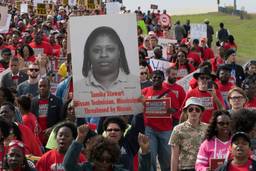‘People Are Pissed Off’: An Interview With Leo Gerard
After attending protests in Madison, Wis., the United Steelworkers union president talks strategy.
David Moberg

Leo Gerard is the international president of the 850,000-member United Steelworkers, the nation’s largest manufacturing union. Although his union represents only a small number of public workers, Gerard has attended protests in Wisconsin and elsewhere since they began in February. On March 3, after the biannual AFL-CIO executive council devoted most of its spring meeting to discussing Republican initiatives in at least a dozen states to weaken or destroy collective bargaining and unions (especially in the public sector), Gerard, a Canadian, talked with In These Times about what the showdown in Wisconsin and other states means for the labor movement.
Why is what’s going on in Wisconsin and beyond important?
For the first time in years, we have a real opportunity to educate citizens on the importance of collective bargaining and unions. Many people didn’t know, and still don’t know, what collective bargaining is. But when they see it being debated on television, on the radio and in streets, and they see people who look just like them standing up for the right to have a voice at work, that is a tremendous education.
What was the mood like at the AFL-CIO executive council meeting in early March?
There was greater unity than I’ve seen in the 10 years I’ve been on the Council. There was a determination by everyone that an injury to one was an injury to all. If they win round one in Ohio, that doesn’t mean the battle is over. We’re going to look at doing recalls on every Republican that is subject to recalls. We’re going to engage every one of our members and fight.
The labor movement can’t be wiped out of existence. You know, when there were no rules about creating unions, we still created unions. If you look at countries where workers have been isolated whether its Poland or whether its Egypt or whether it was Brazil during the military dictatorship – they form unions. They may be trying to wipe us out, but it’s brought us closer together.
We’ve had people who are our members who simply went to work at the start of their shift and the union was there. They were just members. Now they are phoning us and asking, “What can I do?” It’s created an awakening because people understand that for the last 12 years, we’ve been coddling the rich at the expense of the rest of us. People are pissed off.
Was there any agreement at the AFL-CIO executive council meeting on short- and longer-term plans?
The commitment that we made is that we’re in this for the long run. It’s not about six days, six weeks, six months. It’s whatever it takes. That’s the commitment we made to each other.
What’s really fascinating is that you watch the debates going on in each state, and in each state, it’s not about the economy. It’s about Republicans trying to defund the labor movement, because they see the labor movement as one of the last organized resistance to total Republican/corporate dominance of the political agenda. So that’s the fight.
Is this an opportunity to stiffen the backbone of Democrats and the president? How well do you think they’ve responded?
I think the president and [his] cabinet have been very good in speaking out. There are some who say he ought to show up [at the demonstrations]. I don’t think he ought to show up. This can’t be an issue of Republicans versus Democrats. This is an issue of basic fairness and justice. This is an issue of whether or not this is a country where people have a say in their economic destiny and how their work is done. Americans believe in that.
Unions are instruments of social and economic justice, and they’re instruments of democracy. When you go to these rallies, what you see are young people, more than older people, calling out, ‘This is what democracy looks like.’ There’s a cross-section in these rallies – businessmen, lawyers, policemen, firemen. When was the last time you saw policemen, who were told to evict protesters from the Wisconsin capitol, say, “No, we’re going to sleep in there with them tonight and protect the protestors”?
Is there a way to turn this into an organizing opportunity?
Yes. People are getting to see a labor movement that’s on their side, not just the side of members. [W]hile we worry about our members, we worry about the greater society, because if the society doesn’t do well, our members can’t do well.
As one of the kids said when I was in Wisconsin and I asked him if he was enjoying the protest, “My dad was a union member, and my job is to make unions cool again.” Something is happening.
David Moberg, a former senior editor of In These Times, was on staff with the magazine from when it began publishing in 1976 until his passing in July 2022. Before joining In These Times, he completed his work for a Ph.D. in anthropology at the University of Chicago and worked for Newsweek. He received fellowships from the John D. and Catherine T. MacArthur Foundation and the Nation Institute for research on the new global economy.









